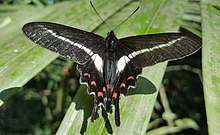Parides proneus
Parides proneus is a species of butterfly in the family Papilionidae. It is found in Brazil and Paraguay.
| Parides proneus | |
|---|---|
 | |
| Parides proneus observed in Brazil | |
| Scientific classification | |
| Kingdom: | |
| Phylum: | |
| Class: | |
| Order: | |
| Family: | |
| Genus: | |
| Species: | P. proneus |
| Binomial name | |
| Parides proneus (Hübner, [1831]) | |
| Synonyms | |
| |
Description
Males and females:both wings with narrow white band, the red submarginal spots of the hindwing straight or slightly curved; anal spot not v-shaped. No discal spot proximalof the anal submarginal one. Width of central band and the number of spots composing it on hindwing variable.[1] A full description is provided by Rothschild, W. and Jordan, K. (1906).[2]
Life cycle
The larva feeds on Aristolochia melastoma.
Taxonomy
Parides phalaecus is a member of the ascanius species group [2] [3] ("Fringe-spots white. Hindwing with submarginal spots and usnally also discal spots or dots, or a discal band ; a quadrate whitish spot in space 2 of the forewing ;mostly with tail).A quadrate whitish spot in space 2 of the forewings is quite peculiar of the ascanius group[4]
The members are
- Parides agavus (Drury, 1782)
- Parides alopius (Godman & Salvin, [1890])
- Parides ascanius (Cramer, [1775])
- Parides bunichus (Hübner, [1821])
- Parides gundlachianus (C. & R. Felder, 1864)
- Parides montezuma (Westwood, 1842)
- Parides phalaecus (Hewitson, 1869)
- Parides photinus (Doubleday, 1844)
- Parides proneus (Hübner, [1831])
Status
A common species and not known to be threatened.[5]
References
- Seitz, A. ed. Band 1: Abt. 1, Die Großschmetterlinge des palaearktischen Faunengebietes, Die palaearktischen Tagfalter, 1909, 379 Seiten, mit 89 kolorierten Tafeln (3470 Figuren)

- Rothschild, W. & Jordan, K. (1906). "A revision of the American Papilios". Novitates Zoologicae. 13: 411-752. (Facsimile edition ed. P.H. Arnaud, 1967)

- Edwin Möhn, 2007 Butterflies of the World, Part 26: Papilionidae XIII. Parides Verlag Goecke & Evers Verlag Goecke & Evers ISBN 9783937783277
- Racheli, Tommaso an Olmisani. Luca 1998. A cladistic analysis of the genus Parides Hubner, [1819], based on androconial structures (Lepidoptera: Papilionidae). Neue Ent. Nachr. (Marktleuthen),41:119-131.pdf
- Collins, N. Mark; Morris, Michael G. (1985). Threatened Swallowtail Butterflies of the World: The IUCN Red Data Book. Gland & Cambridge: IUCN. ISBN 978-2-88032-603-6 – via Biodiversity Heritage Library.
- Möhn, Edwin (2006). Schmetterlinge der Erde. Butterflies of the World Part XXVI (26), Papilionidae XIII. Parides. Edited by Erich Bauer and Thomas Frankenbach Keltern: Goecke & Evers; Canterbury: Hillside Books. ISBN 978-3-937783-27-7 (Supplement 13 in English - by Racheli)
External links
- Butterfly Corner Images from Naturhistorisches Museum Wien
- Images of the type specimen